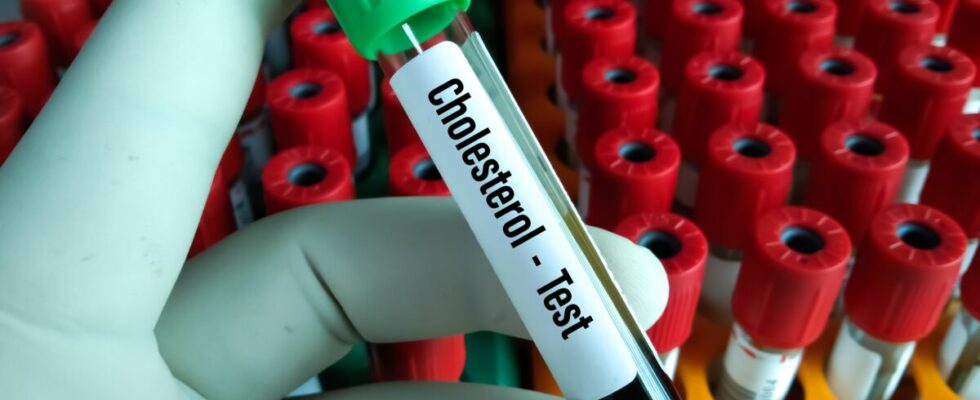Leading cause of acquired disability in adultsstroke strikes more than 140,000 people each year in France, or one case every four minutes. However, almost 80% of strokes could be avoided at the individual level by controlling risk factors, including hypercholesterolemia, that is to say an LDL cholesterol level that is too high.
What is cholesterol? What is the difference between LDL and HDL cholesterol?
Cholesterol is a lipid (fatty body) which comes 70% from the liver (endogenous production) and 30% from our diet. There are two types of cholesterol:
- HDL cholesterol, for “high density lipoproteins”, also called “good cholesterol” prevents the formation of atherosclerotic plaques on the wall of the arteries. “High-density lipoproteins will in fact bring excess cholesterol accumulated in the organs to the liver so that it can be eliminated there”explains Professor Denis Vivien.
- Conversely, LDL cholesterol for “low density lipoproteins”, will promote lipid deposition and the appearance of fatty plaques along the walls of the arteries (atheroma). “A bit like a chimney flue becomes clogged with soot!”, illustrates the specialist. And to add: “If diet has an impact on our cholesterol levels, genetics also influence. For example, some individuals naturally have quite high HDL levels”specifies the director of the Blood & Brain Institute.
Hypercholesterolemia: how to diagnose it?
A silent killer, hypercholesterolemia develops over the years without any visible symptoms. This is why it is recommended to carry out a lipid profile every 3 to 5 years. The diagnosis of hypercholesterolemia is mainly based on a fasting blood test.
“The LDL cholesterol level must be less than 1.60 g/L in people who have no other risk factorsrecalls Professor Pierre Amarenco, neurologist. On the other hand, in those who have associated high blood pressure, diabetes or who smoke, the level must be below 1g/L. Finally, if you have already had a myocardial infarction or stroke, the level must be below 0.55 g/L.”
All international studies tend to show that lowering LDL cholesterol reduces the risk of myocardial infarction and stroke without collateral effects. “For a long time it was believed that too low cholesterol could promote brain hemorrhages, but this is false.admits Professor Amarenco. This was a bias in epidemiological studies. Today, we know that using statins and maintaining low LDL cholesterol levels reduces the risk of stroke without increasing the risk of cerebral hemorrhage. Moreover, after a stroke, a cholesterol level below 0.7 g/L would reduce the risk of recurrence by an additional 25%.
What is a stroke? What are the warning signs?
A stroke occurs when blood flow – to or within the brain – is interrupted. There are two types of stroke:
- ischemic stroke also called cerebral infarction which most often results from occlusion of a cerebral artery by a blood clot;
- cerebral and meningeal hemorrhages linked to rupture of a cerebral artery.
Stroke manifests itself with symptoms such as:
- a loss of sensitivity in an arm, a leg, the face or an entire side of the body;
- muscle weakness or paralysis of one or more limbs or face;
- sudden difficulty finding words, expressing yourself or understanding;
- a sudden disorder of balance or coordination of the limbs;
- sudden loss of vision or half the field of vision in one eye; double vision (diplopia);
- vigilance disorders;
- a sudden, unusual and intense headache.
What are the risk factors for stroke?
The risk factors for stroke are:
Finally, hormonal treatments also increase the risk of thrombosis when combined with other risk factors such as tobacco.
How to prevent stroke?
Screening and treating risk factors, knowing how to recognize warning signs (TIA) and adopting a better lifestyle help prevent stroke.
Know your risk factors
“Know your numbers!”, insist the prevention campaign posters of the American Heart Association. “Know your blood pressure, cholesterol and blood sugar numbers”, insists the neurologist. Screening for and treating risk factors reduces the risk of having a stroke. As such, the Vaincre l’AVC foundation, chaired by Professor Amarenco, has developed a test to complete online. “All you have to do is answer 11 questions, including your blood pressure, blood sugar and cholesterol levels, and you will instantly receive a personalized report on your risk factors as well as recommendations by email.”
TIA: knowing how to spot the warning signs of a stroke
In 30 to 40% of cases, the stroke is preceded by a transient ischemic attack (TIA). “It’s a bit like the smoke from the volcano before the explosionwarns the specialist. The symptoms are more or less the same as those of a stroke but they only last a few minutes. This is a warning sign because in a third of cases, a stroke occurs in the days that follow. AIT must therefore absolutely lead to urgent consultation, even if things return to normal.” And to add: “If the signs have disappeared, you should take 300 mg of aspirin and go immediately to a TIA clinic. On the contrary, if the symptoms are still present, you should not take aspirin and contact 15 .”
Adopt healthy and dietary measures
Finally, simple health and diet measures: reduce your consumption of foods rich in fat such as cold meats, fried foods, processed products or even dishes with sauces; increase your consumption of fruits and vegetables (5 or more servings per day ideally), prefer fatty fish rich in omega-3 (salmon, sardines, etc.), consume legumes (lentils, chickpeas, etc.) and practicing regular physical activity reduces the risk of cardiovascular events. “In primary prevention, we know that physical exercise reduces the risk of stroke and myocardial infarction by 20%”, concludes Professor Amarenco. Enough to put on your sneakers and follow the recommendations of the World Health Organization to the letter: 2.5 hours of intense physical activity (cycling, swimming, running, etc.) or 5 hours of moderate physical activity (gardening, brisk walk) per week.
Sources
